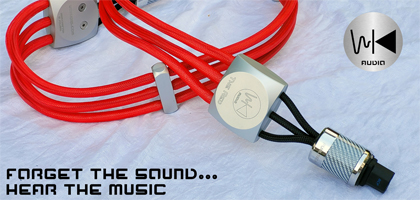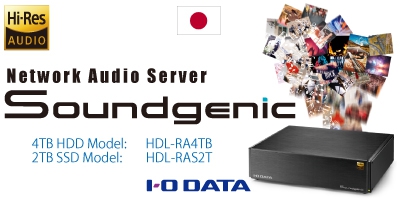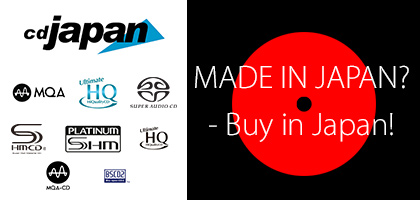No. 240 May 2024
- COVER REVIEW: Norma Audio Electronics REVO CDP-2 ⸜ Compact Disc player » ITALY
- INTERVIEW: ENRICO ROSSI ⸜ Norma Audio Electronics • designer » ITALY
- MUSIC ⸜ Our Albums Series: HAPPY END, BSCD2 ⸜ 1970/2023 » JAPAN
- REVIEW: Audio Reveal HERCULES ⸜ digital-to-analog converter » POLAND
- REVIEW: Ayre EX-8 2/0 ⸜ integrated amplifier » USA
- REVIEW: Cyrus CDi-XR ⸜ Compact Disc player » GREAT BRITAIN
- REVIEW: S.M.S.L PL200 ⸜ Compact Disc player (MQA-CD) » CHINA

|
Editorial
Text by WOJCIECH PACUŁA |
 |
No 240 May 1, 2024 |
|
FOURTY YEARS OF COMPACT DISC
SOME TIME AROUND 1952, American composer John Cage entered a Harvard University anechoic chamber built during World War II, which by definition was supposed to be completely silent. As Robert Barry writes in his monograph on the Compact Disc, its purpose was not to study the propagation of sound waves that make up music, but to study how soldiers hear orders given by their superiors during a bombardment, in a tank, etc. (Bloomberry, p. 36) 
⸜ Top-loader CD Player – S.M.S.L PL200. As it turned out, Cage did not experience silence at all, and the sounds he heard came from his own body: the high sounds were echoes of his nervous system's workings, and the low sounds were those of his circulatory system. As he said later, he felt as if an alien had taken up residence in his body, and he himself "was a machine" over which he "had no control." The conclusion he drew from this experience was that there is no such thing as absolute silence. And this is the genesis of Cage's famous piece, entitled 4'33" - he was concerned with capturing not the silence as such, but the silence "between" the musicians, "between" the audience, i.e. not silence at all, but noise, sounds, etc. Each performance of the piece was completely different, because the set of sounds it revealed, which are masked by the music, was different. For years, the composer did not allow his work to be recorded, and only after the advent of digital recorders and the Compact Disc did he decide to do so - as the digital system offered almost complete silence. The already-cited Barry, author of a publication entitled Compact Disc, recalls in this context the figure of French philosopher Jean Baudrillard, who visited Japan in the mid-1970s, where he was seated in a specially adapted room by a high-end system and heard music played from a digital medium - probably a Denon reel-to-reel tape recorder. As he said, it was like pornography, and "technology is digging its own grave". The possibilities on the one hand and the fears on the other are two sides of the same coin, and the ripples caused by both supporters and opponents of this invention are still felt today. At a conference convened on March 8th 1979, Philips, the future co-creator of the format, astonished the world by publicly showing the silver disc, which Philips had already christened Compact Disc in 1977 - that's why we're talking about the 45th anniversary of the format. The first CDs were unveiled on August 17th 1982, although the first tests at the Polydor Pressing Operations factory were conducted a year earlier (more → HERE). 
⸜ King Crimson albums released as 7’’ Platinum SHM-CD. The first CD released by Sony was Billy Joel's 52nd Street or ABBA’s The Visitors - depending on the source (more → HERE). The first CD player, the Sony CDP-101 model, hit Japanese stores on October 1st of the same year, and American stores in early 1983. The first CD whose sales overtook those of LPs was the album Brothers in Arms by Dire Straits (1985), recorded, incidentally, on Sony's DASH system digital reel-to-reel tape recorders, and in 1987 CD sales surpassed LP sales globally. The Compact Disc saved the music industry, tottering after the problems of the 1970s, and pumped incredibly large amounts of money into it. But that’s not what I wanted to talk about, in fact I wanted to share with you some thoughts on what remains of this fantastic idea in the second half of the second decade of the 21st century. And there is surprisingly much left. You know that the technology industries are based on so-called basic research. That is, those on which only later detailed research is based aimed at developing these discoveries and, as they say today, monetizing them. The problem is that for many, many years the former have been in decline, while the "system", as I guess that's what we can call the Western way of flowing ideas, concepts, inventions and products, is geared solely to profiting from what was invented earlier, by someone else, for which someone else paid - and in almost 100% it was state money, supporting small start-ups or subsidizing research centers, because only states were able to carry such a burden. The Compact Disc was the last format in the audio world that was based on basic research. From the beginning, the format gained influential opponents, who, although not guided by Baudrillard's concerns, pointed out the "unnaturalness" of the format, and thus the "unnatural sound" of CDs. But just as quickly it gained recognition among most sound engineers, and later also among ordinary listeners. It is no coincidence that the vast majority of mastering engineers I know - except for a few examples, such as Dirk Sommer of Sommelier Du Son Publishing, or Bernie Grundman of Bernie Grundman Mastering - downright loathe LPs, and yet they have to prepare "master" files for them, because fashion has forced a return to "analog". And, in fact, to the vinyl record, because the signal recorded on them is almost always converted to ones and zeros somewhere along the way. 
⸜ Cyrus CDi-XR CD Player is a device with slot transport mechanism. So we live in a schizophrenic era, where publishers pretend to sell analog records, and customers pretend to believe - or really believe - that they are buying analog records. And almost everyone, in aggregate, shuns the CD, which to them is a relic and a reminder of the sad days of its dominance. At the same time, too, the same publishers and the same customers are unabashedly - appropriately - using and taking advantage of streaming services to distribute "streamed", and therefore digitally distributed sound, as widely as possible. The CD is stuck somewhere "in between" after what was and what is. What was, brings publishers a lot of revenue, as the margins on LPs are the highest in years. For music listeners, it's a nostalgic memory or participation in contemporary culture, and in that culture the figure of the "black record" is particularly prominent. What will be, on the other hand, is exploited equally by both sides, both because of the lack of distribution outlays, and because of the almost free access to most music libraries in the world. The artists are forgotten by all, and it is the group most financially harmed by the current model. I am not writing this as an apologist for Compact Disc. Nor am I writing this as an opponent of "analog" or a hater of streaming. I am merely trying to draw your attention to things that escape us being covered up by the uproar, be it the battles between "vinyl" and "digital" proponents, or the marketing bubble about the "warmth" of the LP or the enticement of millions of tracks "a click away". All these forms of expression of the recorded musical signal are, in my opinion, legitimate, and each has an important role to play. |
I would see the role of the Compact Disc - let me discuss the two extreme proposals at another time - as popularizing music through a physical object. Because, we now know, haptics, that is, information reaching our brains through the sense of touch, are as important as any other, including sight. They are all the more undervalued because we don't realize their power. After years of convincing us to use book readers - I use one myself and am very happy with it - we now know that we remember much less and understand less from the text we read this way. 
⸜ CD Ayre CX8 CD Player featuring a classic „drawer”. The same is true, it seems to me, with music. And that's why many of us, myself included, like to listen to a vinyl record. It has its own weight, size, the process of playing it requires a lot of coordinated action. It can be washed, treated with an anti-static gun, etc. We touch it and the turntable many times before we even start listening to music. And that's what works well for us, that's part of the belief that vinyl plays better than digital. However, the problem with this carrier is not the sound at all, because it can be outstanding, but exactly what I mentioned, namely the physicality. For the average user who just wants to listen to music, this may be too much. Especially since, after all, the turntable itself also requires meticulous handling and setup. Against this backdrop, the CD appears to be almost effortless. Smaller, but there is a cover, the disc also has to be removed from the box and placed in the CD player. There is thus an interaction between us and the music carrier. We don't just listen to it, we are part of the process. And on top of that CDs, if handled sensibly, actually last "forever". Unlike both of these forms, listening to streamed music is far more passive form. It's obvious that you have to go into a library, be it a streaming service or your own NAS, you have to select an album or song, maybe even specify what quality or format you want to listen to it in, but it's an apparent action, similar to rubbing the screen with your finger while reading a book on an e-reader. And it's not the same as rearranging the pages, as studies of brain activity show. Look at what is happening in education. After years of glorifying digital tools, there is a return to handwriting, preferably with pen and pencil. It turned out that in this way students memorizes up to dozens (!) percent more material and that they remember much more of it after some time has passed. The same learning done with a tablet caused the information, and thus the skills, to disappear very quickly. Studies of this type have been conducted quite often now, on different groups, and the results are consistent. 
⸜ Daniel Hertz Maria amplifier featuring an algorytm that is supposed to improve digital signal. So why can't a CD be the equivalent of a pencil and a printed book for us? Let's think of it as working on ourselves. Streaming? - Certainly and absolutely, but, in my opinion, as a place to find news, develop knowledge, etc. But when it come to listening to music we should rather use a physical medium, because it is better for us, for our bodies. There also remains, of course, the argument for "analog", raised from time to time in connection with studies using functional resonance when listening to analog and digitally generated music. These show that our brains then behave differently. They are often interpreted to mean that "analog" calms us down, while "digital" mobilizes us in a "fight or flight" response. It is in this path of thought that Mark Levinson (yes, THE Levinson) has followed in his latest product, the Maria amplifier, sold under the Daniel Hertz brand. This is because he equipped the amplifier with a DAC with a DSP chip. This chip stores an algorithm that causes time shifts in the digital signal, making the listening brain behave as if it were listening to analog music (you can find more in the test published in this issue of HIGH FIDELITY - 4/2024). And now - I have a similar opinion on this topic, but I draw different conclusions from it. It is indeed the case that listening to an LP is usually relaxing. Not always, nor even very often, but - usually. Studies show that this is because our brains are not subjected to stress. I believe that a CD (and even more so an SACD) can affect us in a similar way. But it has to be a CD played the right way. My intuition is that these are the players I like best - and I like them because I don't get stressed with their sound, in fact I relax. 
⸜ XRCD discs were one of the best ideas of how digital signal should look like Therefore, forty-five years after the first presentation of the Compact Disc format, its future looks quite bright to me. We live in a time of a kind of plateau, so to speak. Technology will turn listening to music from a cylinder or shellac into something intangible, available - in theory - anywhere in the world in unlimited quantities. On the other hand, however, nothing has been happening in this regard for years. That's why publishers have been pushing the market so hard, so overwhelmingly, to take an interest in Dolby Atmos encoded discs believing that by doing so they will repeat the success of the CD. But these are only appearances, in fact, we are using technical studies created decades ago. And this also applies to streaming. There is nothing new on the horizon, because no one is interested in anything new. More bits? - There you go! Higher sampling rates, surround sound 7.2.2 and higher (in corpo-talk: "immersive")? - sure, we have that too. However, let's admit that this is no progress at all, but going in circles. That's why Compact Disc seems to me such a successful format. It's well made, played on a cool player it sounds very good. And it doesn't have to cost that much at all, and it's trivially easy to use, inexpensive, and the medium is a physical object and belongs to us. CD is, in my opinion, the ideal "middle format" that has a chance to be with us for the next forty-five years, if not longer. To honorably celebrate with you 45 years of the Compact Disc format, in the April issue of "High Fidelity" we will present three CD players, each with a different type of disc loading: the S.M.S.L PL200 top-loader, the Cyrus CDi-XR with a slotted transport and the Norma CDP-2 with a classic drawer - the latter will be also featured on our cover. It so happens that lately increasingly more manufacturers offer devices of this type, let me point to Accuphase, Luxman, Pioneer, Denon, Teac or Ayon Audio, but also Cambridge Audio, Naim, Shiit, NuPrime, Canor, JBL, Ayre, CEC, Ancient Audio, dCS, Simaudio, Emotiva, Rega, Gold Note, Audionet, Hegel, Primare, Musical Fidelity, Pro-Ject, Gryphon, and many Asian manufacturers also offer portable devices. Things are really starting to happen.... ● WOJCIECH PACUŁA |
About Us |
We cooperate |
Patrons |
|
Our reviewers regularly contribute to “Enjoy the Music.com”, “Positive-Feedback.com”, “HiFiStatement.net” and “Hi-Fi Choice & Home Cinema. Edycja Polska” . "High Fidelity" is a monthly magazine dedicated to high quality sound. It has been published since May 1st, 2004. Up until October 2008, the magazine was called "High Fidelity OnLine", but since November 2008 it has been registered under the new title. "High Fidelity" is an online magazine, i.e. it is only published on the web. For the last few years it has been published both in Polish and in English. Thanks to our English section, the magazine has now a worldwide reach - statistics show that we have readers from almost every country in the world. Once a year, we prepare a printed edition of one of reviews published online. This unique, limited collector's edition is given to the visitors of the Audio Show in Warsaw, Poland, held in November of each year. For years, "High Fidelity" has been cooperating with other audio magazines, including “Enjoy the Music.com” and “Positive-Feedback.com” in the U.S. and “HiFiStatement.net” in Germany. Our reviews have also been published by “6moons.com”. You can contact any of our contributors by clicking his email address on our CONTACT page. |




 |
     |
main page | archive | contact | kts
© 2009 HighFidelity, design by PikselStudio,
projektowanie stron www: Indecity










